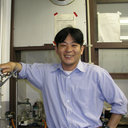A chemical biology approach reveals an opposite action between thermospermine and auxin in xylem development in Arabidopsis thaliana.
Keywords
Abstract
Thermospermine, a structural isomer of spermine, is produced through the action of ACAULIS5 (ACL5) and suppresses xylem differentiation in Arabidopsis thaliana. To elucidate the molecular basis of the function of thermospermine, we screened chemical libraries for compounds that can modulate xylem differentiation in the acl5 mutant, which is deficient in thermospermine and shows a severe dwarf phenotype associated with excessive proliferation of xylem vessels. We found that the isooctyl ester of a synthetic auxin, 2,4-D, remarkably enhanced xylem vessel differentiation in acl5 seedlings. 2,4-D, 2,4-D analogs and IAA analogs, including 4-chloro IAA (4-Cl-IAA) and IAA ethyl ester, also enhanced xylem vessel formation, while IAA alone had little or no obvious effect on xylem differentiation. These effects of auxin analogs were observed only in the acl5 mutant but not in the wild type, and were suppressed by the anti-auxin, p-chlorophenoxyisobutyric acid (PCIB) and α-(phenyl ethyl-2-one)-IAA (PEO-IAA), and also by thermospermine. Furthermore, the suppressor of acaulis51-d (sac51-d) mutation, which causes SAC51 overexpression in the absence of thermospermine and suppresses the dwarf phenotype of acl5, also suppressed the effect of auxin analogs in acl5. These results suggest that the auxin signaling that promotes xylem differentiation is normally limited by SAC51-mediated thermospermine signaling but can be continually stimulated by exogenous auxin analogs in the absence of thermospermine. The opposite action between thermospermine and auxin may fine-tune the timing and spatial pattern of xylem differentiation.



